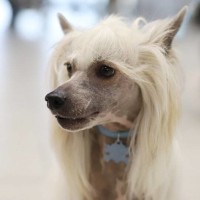Appearance of the Crustie
|
| The Crustie has no breed standard and can resemble either the Chinese Crested Dog or the Yorkshire Terrier. They weigh an average of 3 to 6 kilos and measure between 20.5 and 30.5 centimeters. Its erect, floppy ears are more likely to resemble the Yorkshire Terrier. Its coat can vary considerably, from hairless to straight, fine and silky. His expression remains alert at all times. His small frame is slightly muscular and well built. Its tail is generally full and runs parallel to its body. |
Temperament of the Crustie
|
| The Crustie is known for being cheerful, fun-loving, playful and full of energy. Its liveliness makes it an excellent choice for families looking for an endearing breed. Crusties prefer to cuddle you and make sure you give them your undivided attention. Don't spoil him with too much attention or he'll become demanding and expect good things all the time. The Crustie is a notorious barker and will need early training to stop nuisance barking. This lively dog is excellent with other dogs but may need further instruction on how to handle small animals. Because of his protective nature, your adorable dog will need early socialization to fully accept strangers. If he's sensitive and doesn't like to be left alone for long periods, your Crustie will learn to get used to your schedule if he receives positive reinforcement when you leave and when you return. |
Needs and activities of the Crustie
|
| Crusties have high energy levels, which are at their best with 45 to 60 minutes of exercise a day. Around 2 walks a day are recommended to maintain his healthy weight and figure, and in addition to his walk, he'll enjoy running or playing a game of ball. The ideal environment for your Crustie will be a medium-sized urban home with a fenced yard in a warm climate. Apartment living is acceptable as long as he has the necessary outlets to expend his energy. He'll love to go wherever you go, just make sure he's dressed warmly when it's cold outside and has plenty of fresh water when he's exercising in hot weather. |
Maintenance of the Crustie
|
| The Crustie is not considered a hypoallergenic breed and will shed moderately. Daily brushing for 15 minutes with a firm bristle brush and a greyhound comb will remove dead hairs. The Crustie may inherit sensitive skin due to the genes of the Chinese Crested Dog. In this case, we recommend using a hypoallergenic shampoo to avoid irritants. This breed is not known for drooling or strong odors. Nails should be trimmed every 2-3 weeks, and ears checked weekly for redness, mites or wax build-up. Teeth should be brushed regularly to prevent tartar build-up. Grooming may be necessary if he develops a disheveled appearance. Scissor grooming should be carried out every 4 to 6 weeks for maintenance. |









 English (United Kingdom)
English (United Kingdom)